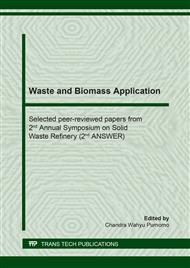[1]
H.I. Farida, L.J.G. Van der Maesen, Plants Resources of South-East Asia no. 11. Auxillary Plants, Prosea Fondation. Bogor. (1997).
Google Scholar
[2]
K. Pinyopusarerk, E.R. Williams, V. Luangviriyasaeng, K. Pitpreecha, Variation in growth and morphological characteristics of Casuarina junghuhniana provenances grown in Thailand, J. Trop. For. Sci. 17(2005) 574-587.
Google Scholar
[3]
S.N. Marsoem, D. Irawati, Basic properties of Acacia mangium and Acacia auriculiformis as a heating fuel, AIP Conference Proceedings 1755 (2016); https://doi.org/10.1063/1.4958551.
DOI: 10.1063/1.4958551
Google Scholar
[4]
M. Palackaa, P. Viciana, M. Holubčíka, J. Jandačkaa, The energy characteristics of different parts of the tree, Procedia Engineering 192(2017) 654 – 658.
Google Scholar
[5]
W. Akpalu, I. Dasmani, P.B. Aglobitse, Demand for cooking fuels in a developing country: to what extent do taste and preferences matter, Energy Policy 39(2011) 6525–6531.
DOI: 10.1016/j.enpol.2011.07.054
Google Scholar
[6]
D. Irawati, Y. Takashima, C. Ueda, J.P.G. Sutapa, S.N. Marsoem, F. Ishiguri, K. Iizuka, N. Yoshizawa, S. Yokota, Ozone treatment of spent medium from Auricularia polytricha cultivation for enzymatic saccharification and subsequent ethanol production, J. Wood Sci. 59 (2013) 522–527.
DOI: 10.1007/s10086-013-1356-0
Google Scholar
[7]
Anonymous. Annual Book of ASTM Standards. Philladelphia.(1984).
Google Scholar
[8]
D. Fengel, G. Wegener, Kayu: Kimia, Ultrastruktur, Reaksi-reaksi. Gadjah Mada University Press. Yogyakarta. (1995).
Google Scholar
[9]
G. Pasaribu, B. Sipayung, G. Pari, Analisa komponen kimia empat jenis kayu asal Sumatera Utara. J. Penelitian Hasil Hutan 25(2007) 1-11.
DOI: 10.20886/jphh.2007.25.4.327-333
Google Scholar
[10]
P. Maan, A. Kadam, D. Dutt. Delignification of L. leucocephala and C. equisetifolia through kraft pulping and mitigation of vessel picking. Bioresources 14(2019) 3512-3527.
Google Scholar
[11]
B.L.C. Pereira, A.M.M.L. Calvalho, A.C.O. Carneiro, L.C. Santos, B.R. Vital, Quality of wood and charcoal from Eucalyptus clones for ironmaster use. Int. J. For. Research (2012), https://doi.org/10.1155/2012/523025.
DOI: 10.1155/2012/523025
Google Scholar
[12]
H. Yang, R. Yan, H. Chen, D.H. Lee, C. Zheng, Characteristics of hemicellulose, cellulose, and lignin pyrolysis, Fuel 86 (2007) 1781-1788.
DOI: 10.1016/j.fuel.2006.12.013
Google Scholar
[13]
R. Kumar, K.K. Pandey, N. Chandrashekar, S. Mohan, Study of age and height wise variability on calorific value and other fuel properties of Eucalyptus hybrid, Acacia auriculaeformis and Casuarina equisetifolia, Biomass and Bioenerg 35(2011) 1339 – 1344.
DOI: 10.1016/j.biombioe.2010.12.031
Google Scholar
[14]
T. Seifert, Bioenergy from wood-Sustainable production in the Tropics. Springers, Dordrecht. (2014).
Google Scholar
[15]
W.D. Jong, J.R. Van Ommen, Biomass as a sustainable energy source for the future. Wiley, New Jersey. (2015).
Google Scholar
[16]
Badan Standardisasi Nasional, Briket arang kayu. Standar Nasional Indonesia 01-6235-2000. Dewan Standardisasi Nasional. Jakarta. (2000).
DOI: 10.14203/press.234
Google Scholar
[17]
B. Esteves, L. Nunes, I. Domingos, H. Pereira, Comparison between heat treated sapwood and heartwood from Pinus pinaster. European J. of Wood and Wood Products 72(2014) 53–60.
DOI: 10.1007/s00107-013-0751-y
Google Scholar



